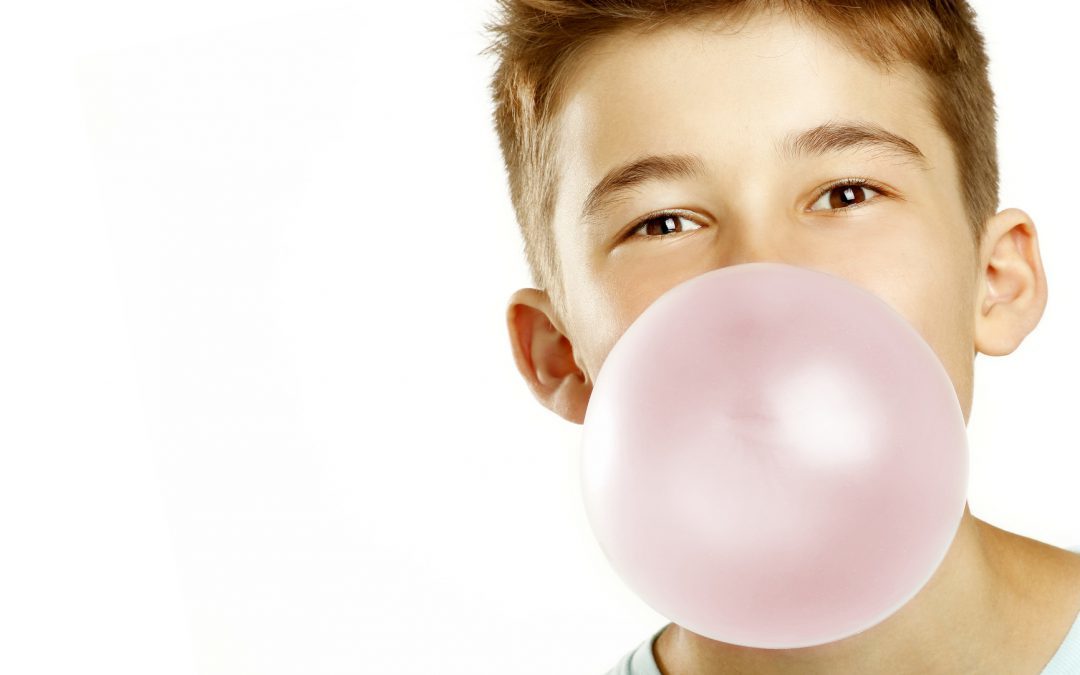Bubble gum can be such a great treat for our kids! From the vibrant colors and exciting flavors, to the joy of popping bubbles, chewing gum can be pretty fun! At South Davis Pediatric Dentistry, parents frequently ask us whether they should let their child chew gum. While the decision is ultimately yours, here are some things you should keep in mind when deciding what is best for your child.
To Chew
There are many reasons chewing gum can be good for your child. It’s a tasty low calorie snack that lasts a long time. But besides that, there are a few other cool things that make chewing gum a healthy choice for your child!
Chewing increases production of saliva
The physical act of chewing increases the flow of saliva which helps wash food particles and neutralizes the harmful acids that cause tooth decay. An increase in saliva flow also helps move calcium and phosphate to your teeth, which strengthens them. Just make sure to choose a sugar free gum to help fight tooth decay. Chewing gum right after eating is a great habit to have to help clean your teeth and get rid of remaining food. Plus, it can be a fun alternative to sugary, high calorie treats.
Chewing gum regularly can strengthen the jaw
A few years ago my jaw was so weak that it hurt to eat hard foods. It got so bad that even chewing cooked carrots was beginning to make my jaw sore. My dentist told me to try chewing some gum to help strengthen my jaw and my biting strength. It worked wonders!
Gum contains helpful Ingredients
Gum containing ingredients like Xylitol, a natural sugar substitute, helps reduce cavities and plaque. Xylitol is sweet and tastes really similar to sugar so children can still get that sugary sweet taste when they chew. Sugar free gum isn’t just for adults anymore. Instead of having the regular mint flavors, most gum brands have yummy flavors like Trident Layers’ Grape Lemonade and Wrigley’s Extra Sweet Watermelon.
Calcium Lactate is another ingredient in chewing gum that can help your kiddo’s teeth get stronger. Calcium Lactate helps remineralize teeth’s enamel surfaces faster and makes teeth stronger so they last longer.
Not to Chew
Despite all these great reasons for chewing gum, there are some downsides to this tasty treat.
Sugary gum causes cavities
It’s pretty common knowledge that eating lots of sugary treats can cause cavities. Most big bubble producing varieties of gum are sweetened with sugar. Even with thorough brushing, the sugar from these sugary gums does significant damage since they are pressed tightly to teeth for long periods of time. The sugar reacts to the bacteria found in dental plaque and produces acids that erode tooth enamel. Sugary gum is no longer as big of an issue due to the discovery of artificial sweeteners but there are a few brands that still use sugar to sweeten gum.
Over-chewing can trigger Temporomandibular Joint Disorder (TMD)
Even though chewing can improve jaw strength, it can go too far. Chewing more than a couple pieces a day can trigger symptoms of TMJ. These symptoms can include jaw pain that is associated to the chewing muscles and the joints that connect the lower jaw to the skull. If your child’s jaw makes popping noises or they feel any discomfort when their mouth opens, have them stop chewing gum.
Gum Poses a potential choking hazard
Young children don’t understand how to chew gum without swallowing yet and it’s up to us to show them how to responsibly chew gum. Since every child’s development is different, there is no age recommendation for safe chewing. So if you have any questions about whether it is a good idea for your child to chew gum, get in touch with one of our dentists at South Davis Pediatric Dentistry.
Whether you choose to let your child chew gum, make sure that gum chewing does not take the place of other healthy habits such as brushing twice a day and flossing! A good dental routine is the best way to prevent tooth decay and cavities while keeping your smile brighter than ever.



Recent Comments